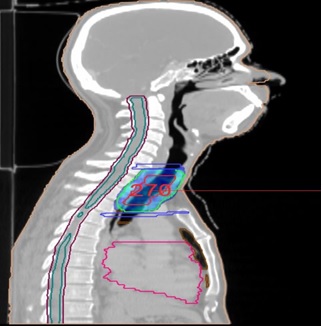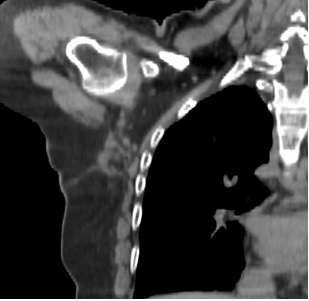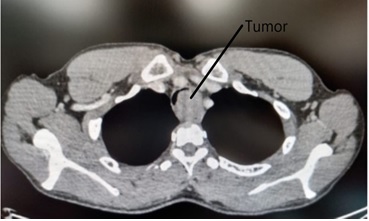Adjuvant Radiotherapy in Primary Adenoid Cystic Carcinoma of Trachea- A Case Series
Download
Abstract
Objective: Only 1% of all malignancies of the respiratory system are adenoid cystic carcinoma (ACC) of the trachea. ACC’s clinical course is frequently lengthy. Most patients first experience dyspnea, which looks like asthma or chronic bronchitis. The primary treatment choice is surgical resection followed by radiotherapy due to the small surgical margins of the tumor. When surgery is not an option, most cancers respond to radiotherapy, which frequently produces prolonged periods of remission.
Method: We present three cases of primary ACC of the trachea. One case involved a 49-year-old man who had tracheal ACC treated surgically and then with radiation. Another 65-year-old female patient underwent surgical resection and adjuvant radiotherapy to treat her recurrent metastatic posterior thoracic wall tumor. At one month follow-up, our patient showed no evidence of disease, and a 38-year-old male presented with complaints of dry cough, breathlessness, and hemoptysis. Bronchoscopy showed a polypoidal growth obstructing more than 2/3rd of the tracheal lumen. The patient underwent excision of the tracheal tumor followed by adjuvant radiotherapy.
Conclusion: Postoperative adjuvant radiotherapy plays an important role in management of ACC and it should be considered in all the patients of ACC to decrease the risk of recurrent disease.
Introduction
Tracheal tumors are exceedingly rare; the incidence rate of primary tracheal tumors is less than 0.2 per 100,000 people [1]. As opposed to benign conditions, maximum tracheal cancers are malignant [2]. Around two-thirds of the primary airway neoplasm’s are squamous cell carcinoma and adenoid cystic carcinoma (ACC) [3]. ACC of the trachea, also known as “cylindroma” and “adenoid cystic carcinoma,” was first described in 1859 by Billroth [4]. Billroth also described its clinical and pathological characteristics. The prevalence of ACC is equal in both sexes and tends to be higher in younger people [5]. ACC doesn’t seem to be associated with smoking. Most ACC patients present with symptoms that frequently resemble those of chronic bronchitis or bronchial asthma. ACC is a low-grade malignancy with slow growth and a prolonged clinical course. Complete surgical removal of the primary tumor is the main treatment for tracheal ACC. However, resectability frequently becomes challenging if the disease involves nearby vital tissues, particularly in individuals with distal tracheal involvement [6, 7] or large tumors. In this instance, radiotherapy is utilized either as a primary treatment option for irresectable tumors or as an adjuvant care method after surgery. We present three cases of tracheal ACC: A 49-year-old man who had a tracheal ACC underwent surgery, then radiation. Another 65-year- old female patient with a metastatic posterior thoracic wall tumor that had returned was removed surgically and received adjuvant radiotherapy, and a 38-year-old man with a polypoidal growth in the tracheal lumen. Following the removal of the tumor, the patient had adjuvant radiation.
Case 1
A 49-year-old male chronic smoker presented with symptoms like asthma in emergency and received supportive treatment but was not got relieved on further investigations a non-tracer avid cyst was found in the paratracheal region. Bronchoscopy showed a pedunculated tracheal mass and biopsy of the mass was suggestive of adenoid cystic carcinoma. The patient underwent mass excision. Post-operative imaging was suggestive of residual mass. Further the patient received adjuvant radiotherapy (Figure 1).
Figure 1. Radiotherapy Dose Distribution in Primary Tracheal ACC.

The patient at first follow-up after 1 month of follow-up was clinically asymptomatic and his CT scan showed no significant abnormality or disease.
Case 2
A 65-year-old female presented with a mass on the posterior chest wall which was excised and the biopsy of which was suggestive of malignant skin adnexal neoplasm which on further IHC was found to be ACC. After 2 months patient again presented with scar hypertrophy at the same site, and radiological imaging also showed few ipsilateral axillary lymph nodes (Figure 2).
Figure 2. CT Image of Axilla Showing Recurrent Disease at Post Surgery Site and Regional Lymph-nodes.

FNAC from the node was suggestive of metastases from primary chest wall disease. The patient again underwent local resection of the hypertrophied scar with axillary lymphadenectomy. Scar mass biopsy showed no evidence of recurrent disease but one lymph node was found to be positive for malignancy. Further, the patient received adjuvant radiotherapy to the post-operative tumor bed and axillary region. On the first follow-up after one month patient was asymptomatic. After three months a PET CT was advised showing no abnormal uptake.
Case 3
38-year male, non-smoker, with occasional history of alcohol intake presented with a swelling in the neck which was associated with dry cough, mild breathlessness, chest pain, and hemoptysis for 2 years. His contrast-enhanced computed tomography (CECT) scan of the thorax was suggestive of a heterogeneously enhancing mass measuring 34×22mm, arising from the left and posterior side of the upper trachea causing severe airway narrowing (Figure 3).
Figure 3. Axial CT Image Showing Primary ACC of Trachea.

Barium swallow showed a filling defect with an irregular outline in the anteromedial border of the upper part of the esophagus. A large polypoidal growth obstructing more than 2/3 rd of tracheal lumen 2 cm below the inferior vena cava was seen on bronchoscopy. Biopsy from the tracheal growth was reported as polymorphous low-grade adenocarcinoma while immuno-histochemistry (IHC) was positive for CD117, P53, SMA, and EMA and negative for S- 100 which concluded it to be a malignant salivary gland-like neoplasm with characteristics of ACC. After evaluation of the patient by a multidisciplinary team including surgeons and a radiation oncologist’s patient was planned for tracheal mass excision followed by radiotherapy. After completion of radiotherapy patient came for first follow-up after one month. A CT scan was advised to patient at third month of follow-up which was found to be normal after which patient was lost to follow-up. A tele-follow-up was done at one year period after radiotherapy on which patient confirmed that he is asymptomatic and doing well.
Discussion
After squamous cell carcinoma, ACC is the second most common tracheal malignant neoplasm [1]. ACC is a slow-growing neoplasm that does not appear to be associated to smoking. Aside from clinical examination, physical examination of the airway via bronchoscopy and CECT thorax in coronal view are the best investigation modalities for any tracheal tumor. In comparison to squamous cell carcinoma, ACC has a lower malignant potential and a better prognosis. A better prognosis is primarily related to the feasibility of complete resection and the absence of metastasis, whereas lymph nodal involvement has not found to be associated with a worse prognosis. Surgery is the primary curative treatment for tracheal tumors. According to Grillo and Mathien et al, complete resection of tracheal tumors is extremely difficult, and when complete resection cannot be achieved, postoperative radiotherapy appears to have a significant influence on overall survival [8]. In all three cases presented, a circumferential resection was performed with no postoperative complications, which was followed by postoperative radiotherapy. After two months of follow-up no local disease was found in these patients. According to Maziak and colleagues’ study, patients with no residual tumor after surgical resection of primary tracheal tumor have a 69% 10-year survival rate, compared to 30% for those with microscopic residual disease [3]. Regnard et al conducted a retrospective study with 65 cases of primary tracheal ACC and observed that adjuvant radiotherapy increased patients’ overall survival [9]. A five-year survival rate of 65-80% was observed in patients with primary tracheal ACC who had received adjuvant radiotherapy in another study conducted by Le Pechoux [7].
In conclusion, based on the presentation of these three cases, we can conclude that surgical resection with reconstruction followed by postoperative adjuvant radiotherapy is the best modality of treatment for primary ACC. We can use modern radiotherapy techniques like IMRT or VMAT to ensure that the organ at risk receives the least amount of radiation possible while maintaining the dosage at the primary tumor volume.
References
- Adenoid cystic carcinoma of the trachea: a report of seven cases and literature review P-Y Yang , M-S Liu , C-H Chen , Ch-M Lin . Chang Gung medical journal.2005;28(5).
- Adenoid cystic carcinoma of the airways: helical CT and histopathologic correlation S-H Kwak , K.S Lee , M.J Chung , Y.J Jeong , G.Y Kim , O.J Kwon . AJR. American journal of roentgenology.2004;183(2). CrossRef
- Adenoid cystic carcinoma of the airway: Thirty-two-year experience Maziak DE , Todd TRJ , Keshavjee SH , Winton TL , Van Nostrand , Pearson FG . The Journal of Thoracic and Cardiovascular Surgery.1996;112(6). CrossRef
- Beobachtungen über Geschwülste der Speicheldrüsen Billroth T. Archiv für pathologische Anatomie und Physiologie und für klinische Medicin.1859;17(5). CrossRef
- A long-term survivor after aggressive treatment for tracheal adenoid cystic carcinoma: a case report R Suemitsu , T Okamoto , R Maruyama , Hiroshi Wataya , Takashi Seto , Yukito Ichinose . Annals of thoracic and cardiovascular surgery : official journal of the Association of Thoracic and Cardiovascular Surgeons of Asia.2007;13(5).
- Adenoid cystic carcinoma of the airway: a 30-year review at one institution Calzada AP , Miller M, Lai CK , Elashoff DA , Abemayor E, St John MA . American Journal of Otolaryngology.2012;33(2). CrossRef
- [Thoracic adenoid cystic carcinomas] Le Péchoux C., Baldeyrou P., Ferreira I., Mahé M.. Cancer Radiotherapie: Journal De La Societe Francaise De Radiotherapie Oncologique.2005;9(6-7). CrossRef
- Primary tracheal tumors: treatment and results Grillo H. C., Mathisen D. J.. The Annals of Thoracic Surgery.1990;49(1). CrossRef
- Results and prognostic factors in resections of primary tracheal tumors: a multicenter retrospective study. The French Society of Cardiovascular Surgery Regnard J. F., Fourquier P., Levasseur P.. The Journal of Thoracic and Cardiovascular Surgery.1996;111(4). CrossRef
License

This work is licensed under a Creative Commons Attribution-NonCommercial 4.0 International License.
Copyright
© Asian Pacific Journal of Cancer Biology , 2022
Author Details